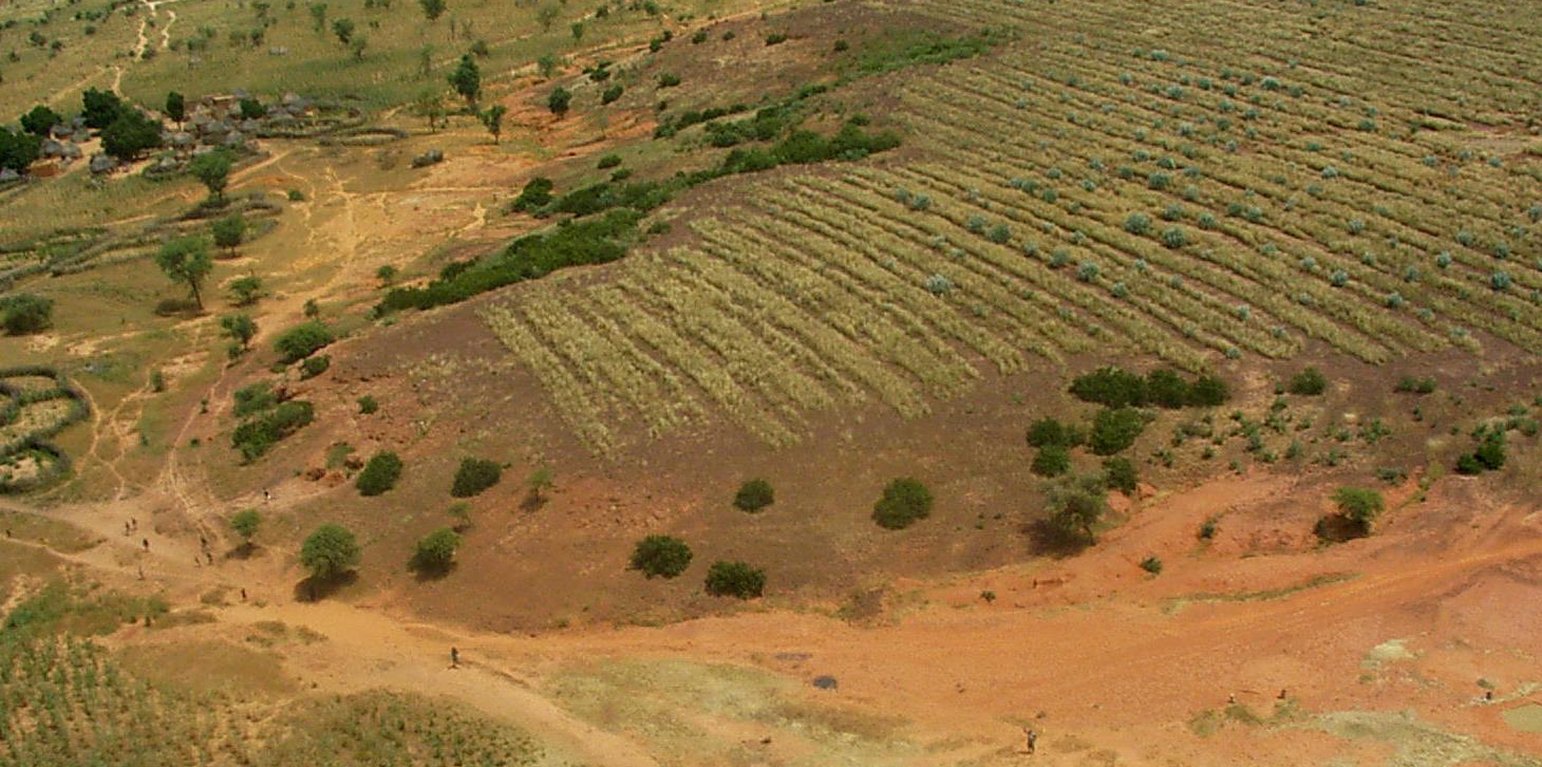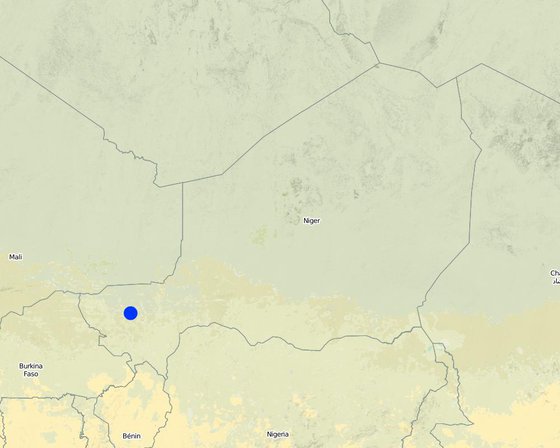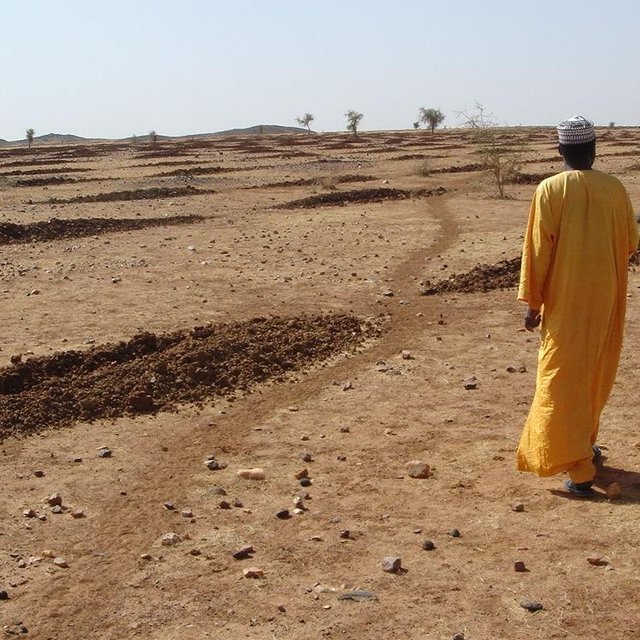



Nardi/Vallerani trenches are microcatchments 4 m long and 0.5 m wide. They are made using a tractor-pulled plough specifically designed for this purpose. The Nardi plough cuts a furrow perpendicular to the slope, throwing up a ridge on the downhill side and thereby creating a barrier on that side of the furrow. The number of trenches varies according to the gradient of the terrain and the type of soil: the recommended number of microcatchments for flat or gently sloping terrain is between 250 and 400 per hectare, with the rows spaced 5 to 7 m apart; and for steeper slopes, the rows should be spaced 3 to 4 m apart, with a density of up to 600 microcatchments per hectare. In each Nardi/Vallerani microcatchment, two or three trees are planted or sown by direct seeding and then separated when they come up. Perennial grasses are sown a year later to allow the trees to become established first. The choice of species largely depends on the use to which the improved land is to be put and the priorities of the beneficiaries. It is recommended that the improved site be protected from grazing animals for at least three years to give the trees time to grow and the grass time to reproduce naturally, although the exact amount of time required will depend on the type of trees planted and how degraded the site is.
Nardi/Vallerani trenches are generally combined with scarification, which is carried out using a tractor-pulled scarifier. The strips between the trenches are scarified a year after they have been dug. These scarified strips are sown with perennial grasses at the same time as the trenches. The trees planted the year before are a year old, and the risk of the saplings being choked by the grass is minimal.
Runoff collects in the Vallerani microcatchments, improving the infiltration of water into the soil and the retention of water for the plants growing in them. They also serve to loosen the soil and improve the plants’ access to nutrients. Windborne seeds are trapped in the microcatchments, which helps to build up the natural grass cover.
This technique is particularly effective when rainfall is low, as the microcatchments retain water and make it available to the plants growing in them.
In the medium term, this technique is effective in protecting the land against water and wind erosion and rehabilitating barren land with no vegetation. In wet years, the microcatchments protect the land downhill from excessive run- off by retaining part of the water.
Implemented on a wide scale, this technique can extend and improve the quality of forest and rangeland and reduce the problems for livestock keepers in years when the quality of pasture is not good. In the medium and long- term, the technique can increase the supply of firewood, timber and other wood products. Even in the short term, it increases the production of straw, which can be used as forage, for making roofing and mats or sold to generate extra income.
Establishment / maintenance activities and inputs: In order to ensure the sustainability of the investment, it is necessary to take the following steps before constructing the trenches: ensure that the communities are motivated to invest in the measure; ensure that the communities have the capacity to do the work and the technical expertise required to implement the measures and develop and manage the sites; ensure that there are sufficiently strong local and regional markets for forest/rangeland products; clearly define the objective (intended uses after improvement); clarify ownership of the land to be improved; jointly define who the beneficiaries will be; formulate an agreement establishing rules governing the protection, use and upkeep of the site.
The right grass species must be chosen to ensure the successful establishment of vegetation cover, taking the following factors into consideration: needs of livestock keepers and/or agro-pastoralists; species suited to environmental conditions, taking into account climate changes; palatability and nutritive value of the species and any secondary uses they may have; availability of seeds; potential for marketing products.
The Sahel is a region where the population has always faced a high degree of climate variability, manifested both in terms of time (unexpected dry spells can occur during the rainy season) and in terms of space (rainfall can vary greatly from one area to another). The population is mainly composed of small farmers and livestock keepers.
Over the last two decades, the effects of climate change have exacerbated the already difficult conditions. Accord¬ing to projections made by climatologists, the Sahel will experience a rise in temperatures combined with highly variable rainfall and an increase in extreme weather events.
The Soil and Water conservation and rehabilitation techniques have helped people in the Sahel to manage their ecosystems more effectively and improve their productive land. As a result, communities are better prepared to cope with environmental changes (changes in the climate, land degradation, etc.) and the im¬pact of shocks, particularly droughts

Location: Regions of Tillabéri, Filingué, Ouallam, Téra and Tahuoa, Niger, Niger
No. of Technology sites analysed:
Spread of the Technology:
In a permanently protected area?:
Date of implementation: 10-50 years ago
Type of introduction











| Specify input | Unit | Quantity | Costs per Unit (CFA Franc) | Total costs per input (CFA Franc) | % of costs borne by land users |
| Labour | |||||
| labour | ha | 1.0 | 16.3 | 16.3 | 100.0 |
| Equipment | |||||
| machine use | ha | 1.0 | 23.6 | 23.6 | 100.0 |
| transport and planting trees | ha | 1.0 | 12.3 | 12.3 | 100.0 |
| Plant material | |||||
| seedlings | ha | 1.0 | 52.0 | 52.0 | 100.0 |
| Total costs for establishment of the Technology | 104.2 | ||||
| Total costs for establishment of the Technology in USD | 0.2 | ||||
It is recommended that the improved site be protected from grazing animals for at least three years to give the trees time to grow and the grass time to reproduce naturally
Implemented on a wide scale, this technique can extend and improve the quality of forest and rangeland and reduce the problems for livestock keepers in years when the quality of pasture is not good. In the medium and long-term, the technique can increase the supply of firewood, timber and other wood products. Even in the short term, this technique increases the production of straw, which can be used as forage, for making roofing and mats or sold to generate extra income. The forest/rangeland sites help communities to bridge the hunger gap, and in lean years, the women collect forest products, such as leaves, pods and fruit to supplement their diet. Sometimes, small quantities of wood are sold to buy cereals. Ingredients for medicinal products and other secondary products, such as gum arabic, are collected from the trees and bushes.
Quantity before SLM: 100 kg/ha
Quantity after SLM: 540 kg/ha